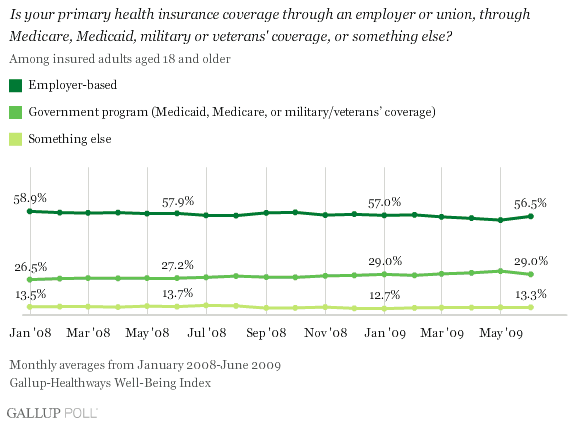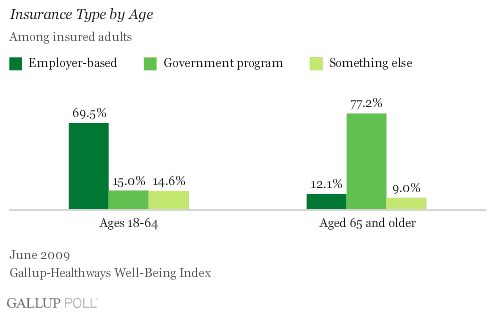WASHINGTON, D.C. -- The Gallup-Healthways Well-Being Index reveals that currently 29.0% of adult Americans who have health insurance get their coverage through the government, a percentage which has increased since early 2008. More than half of insured Americans (56.5%) rely on an employer-based program and another 13.3% of the insured obtain their healthcare coverage through some other means, which includes purchasing it privately for themselves.

The percentage of insured American adults who report getting their insurance through a government program, including Medicaid, Medicare, or military/veterans' coverage, has increased over the last year and a half, to an average of 29.3% in 2009 from 27.5% in 2008. While still a majority, the percentage of insured Americans who have health coverage through an employer or union has decreased to an average of 56.2% in the first half of 2009 from the 2008 average of 57.9%.
In June 2009, 56.5% said they were covered through their employer or union versus 58.9% in January 2008. Currently, 29.0% of insured Americans have coverage through a government program, compared to 26.5% in January 2008. The 29.0% with government insurance in June is the sum total of the 20.4% of adults who have health insurance through Medicare, 4.7% through Medicaid, and 3.9% through military/veterans' coverage. The percent of insured who say their health insurance is through some other source has remained fairly steady -- averaging 13.1% in 2009 and 13.5% in 2008.
These estimates are based on over 470,000 interviews, including approximately 26,000 per month with adults who have health insurance. While the changes are small in absolute terms, they are statistically meaningful based on the large sample sizes.
Older Americans vs. Working-Age Population
As would be expected, insured Americans who are between the ages of 18 and 64 are much more likely than those 65 and older (and thus eligible for Medicare) to be covered through employer-based insurance. In turn, older Americans are more likely than their younger counterparts to be covered through a government program. In June, 77.2% of those aged 65 and older report getting health insurance coverage through a government plan versus 15.0% of those ages 18 to 64.

The trend over time in the percentage of insured Americans aged 65 and older reporting they have health coverage through the government shows some fluctuation month to month, but no significant increase from year to year. There has, however, been a measurable increase in the percentage of insured 18- to 64-year-olds who have health insurance through a government program, averaging 15.7% in the first six months of 2009 versus 14.5% in 2008.

Bottom Line
Previous Gallup research has shown that the overall percentage of adult Americans without health insurance has edged upward over the last year and a half to 16.0% in June 2009 from 14.8% in January 2008. The current data suggest that many of those who have dropped out of the ranks of the insured had employer-based insurance, leaving a larger percentage of the insured pool covered by a government program. Older Americans, as well as those between the ages of 18 and 64, have become less likely to have employer-based health insurance on average in 2009 compared with 2008. At the same time, government health coverage in both age groups has been increasing, pushing the current total percentage of Americans aged 18 and older with health insurance through a government program to 29.0% in June.
Survey Methods
For the Gallup-Healthways Well-Being Index, Gallup is interviewing no fewer than 1,000 U.S. adults nationwide each day. Monthly results comprise roughly 26,000 interviews. For results based on these samples, the maximum margin of sampling error is ±1 percentage point.
Interviews are conducted with respondents on land-line telephones (for respondents with a land-line telephone) and cellular phones (for respondents who are cell-phone only).
In addition to sampling error, question wording and practical difficulties in conducting surveys can introduce error or bias into the findings of public opinion polls.
About the Gallup-Healthways Well-Being Index™
The Gallup-Healthways Well-Being Index is the first and largest survey of its kind, with 1,000 calls a day, seven days a week. It is the official statistic for Wellbeing in America, giving a daily measure of people's wellbeing at the close of every day, based on the World Health Organization (WHO) definition of health as not only the absence of infirmity and disease but also a state of physical, mental, and social wellbeing. The Well-Being Index will be a daily measure determining the correlation between the places where people work and the communities in which they live, and how that and other factors impact their wellbeing. Additionally, The Well-Being Index will increase the understanding of how those factors impact the financial health of corporations and communities. For additional information, go to well-beingindex.com.
